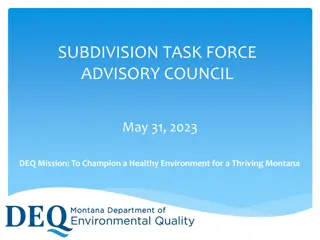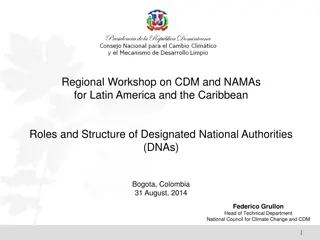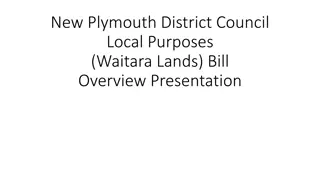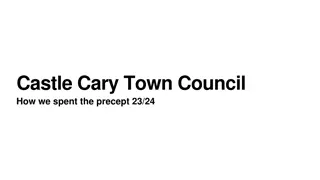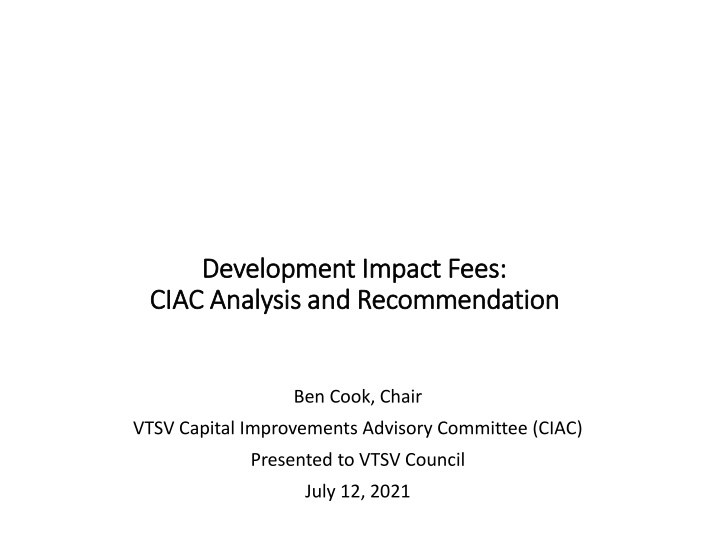
Development Impact Fees and CIAC Recommendations
Learn about development impact fees and the Capital Improvements Advisory Committee (CIAC). Explore the recommendations made by CIAC to update land use assumptions, develop financing plans, secure funding sources, and reassess impact fee schedules. Discover the role of CIAC in advising on capital improvements and monitoring implementation in municipalities and counties.
Download Presentation

Please find below an Image/Link to download the presentation.
The content on the website is provided AS IS for your information and personal use only. It may not be sold, licensed, or shared on other websites without obtaining consent from the author. If you encounter any issues during the download, it is possible that the publisher has removed the file from their server.
You are allowed to download the files provided on this website for personal or commercial use, subject to the condition that they are used lawfully. All files are the property of their respective owners.
The content on the website is provided AS IS for your information and personal use only. It may not be sold, licensed, or shared on other websites without obtaining consent from the author.
E N D
Presentation Transcript
Development Impact Fees: Development Impact Fees: CIAC Analysis and Recommendation CIAC Analysis and Recommendation Ben Cook, Chair VTSV Capital Improvements Advisory Committee (CIAC) Presented to VTSV Council July 12, 2021
CIAC Recommendations to VTSV CIAC Recommendations to VTSV The CIAC unanimously recommended adoption of the land use assumptions and development impact fee schedule* The CIAC also encourages VTSV to 1) Update its Capital Improvements Plan (CIP) 2) Develop a comprehensive financing plan that identifies the necessary sources of funding to execute the remaining CIP, maintenance and operating, and TIDD repayment costs 3) Consider and potentially implement mechanisms to secure additional sources of revenue to finance the CIP 4) Periodically reassess the land use assumptions and development impact fee schedule (required by state statue) *Vote occurred at virtual public meeting held May 20, 2021
VTSV Capital Improvements Advisory Committee (CIAC) VTSV Capital Improvements Advisory Committee (CIAC) CIAC created in accordance with Section 5-8-19 of the NM Development Fees Act to: 1) advise and assist the municipality or county in adopting land use assumptions; 2) review the capital improvements plan and file written comments; 3) monitor and evaluate implementation of the capital improvements plan; 4) file annual reports with respect to the progress of the capital improvements plan and report to the municipality or county any perceived inequities in implementing the plan or imposing the impact fee; and 5) advise the municipality or county of the need to update or revise the land use assumptions, capital improvements plan and impact fee. Note: CIAC is an advisory body with no decision-making authority. CIAC members: Michael Bower Michael Fitzpatrick Katherine Kett Thomas Mastor Paddy McNeely Russell Olson Ben Cook
Background on development impact fees Background on development impact fees Development impact fees are widely used to collect costs associated with capital improvements needed to support new development. Fees are set based on proportional benefit that new development receives from capital improvement projects. Example scenario: Town of High Peaks has a population of 1,000 residents. New development has been proposed that will double the population to 2,000 by 2030. For its Capital Improvements Plan (CIP), High Peak determines it needs to finance two major infrastructure projects, paving its town roads and doubling its sewage treatment plant. 1. Road paving is $10M and benefits both new development and existing residents: Cost allocated to new development = $10M x 1000/2000 = $5M 2. Expanding sewage treatment plant will cost $5M and is only required to enable new development: Cost allocated to new development = $5M High Peaks must set fees to collect $10M of CIP costs allocated to support new development. New development will consist of 250 houses with 4 residents each: Impact fee per unit: $10M/250 units = $40,000 per house
Land Use Assumptions Land Use Assumptions CIAC discussion topics: Historical growth rate Undeveloped lots Potential developments Occupancy rates New development accounts for 38% of 2030 overnight visitors (477/1246)
Capital Improvements Plan (CIP) review Capital Improvements Plan (CIP) review CIP includes approved projects for various infrastructure investments: Public safety facilities Transportation facilities Parks and public spaces Wastewater system development Water system development Village staff have scrubbed CIP in accordance with CIAC recommendation: CIP includes $16M in remaining costs for several major projects underway and/or completed: $2M for Village Hall $13M for wastewater treatment plant $1M for Kachina water tank
Development Impact Fee Schedule and Revenue Projection Development Impact Fee Schedule and Revenue Projection Is $18M reasonable? Proportional allocation of $48M based on new development accounting for 38% of 2030 overnight visitors is equal to $18.4M
Example development impact fees Example development impact fees Example fees: $21K for 2,500 sq ft house $16K for 400 sq ft hotel room $40K for 1,000 sq ft condo $84K for 2,000 sq ft restaurant Commercial development has significantly higher impact on infrastructure in resort communities than residential, which is supported by Village service data: Based on 2019 billing data, multifamily units consume 2.1 times more water than homes
Related considerations Related considerations Several good questions have been raised to the CIAC: 1) Will fees deter affordable housing / retail space? Under state statue, Village can reduce and even waive fees 2) Shouldn t we have a finance plan first? Fees can be set independently and fairly based on proportional benefit A finance plan is needed to address remaining revenue gaps for CIP ($30M), operating and maintenance costs, and TIDD repayment (~$40M) Development impact fee revenues are a valuable input to finance plan 3) Is it unfair to charge the primary developer fees when they have already invested in TIDD infrastructure projects? The TIDD is a loan, not a gift. The Village is obligated to pay the TIDD back with interest. 4) What happens if projects aren t built and/or the Village receives large grants that offset major costs (e.g., Twinning/Kachina road)? Under state statue, developers can request refunds and Village is obligated to provide refunds if project(s) was not completed or costs were lower than estimated in the CIP 5) Should the fee vary by development district to address differential infrastructure costs? Willdan, Village staff, and the CIAC discussed service area districts and determined that the added complexity was not warranted given Village-wide benefit of CIP projects (e.g., water and wastewater expansion is needed to support commercial development in Vilage Core) 6) What about the risk of a shortfall in fee revenues? $18.3M is based on growth projections in the land assumptions and no fee discounts to TSVI, which they can request of the Council under the Master Development Agreement




